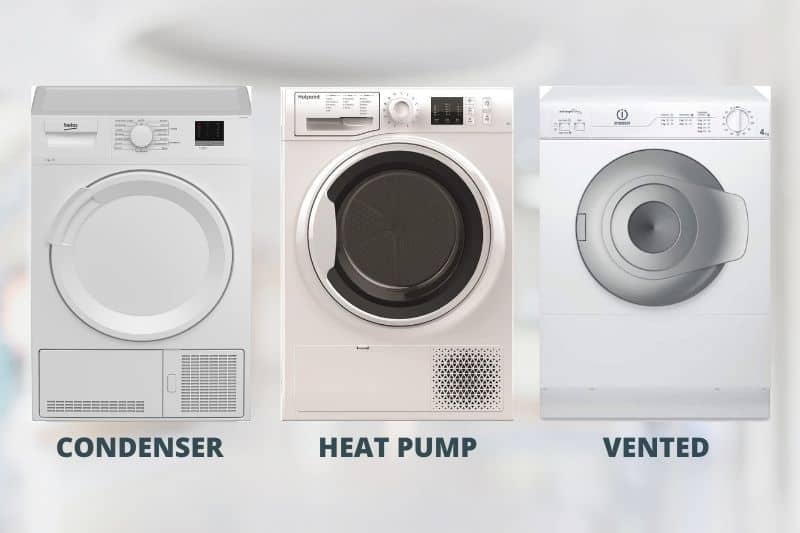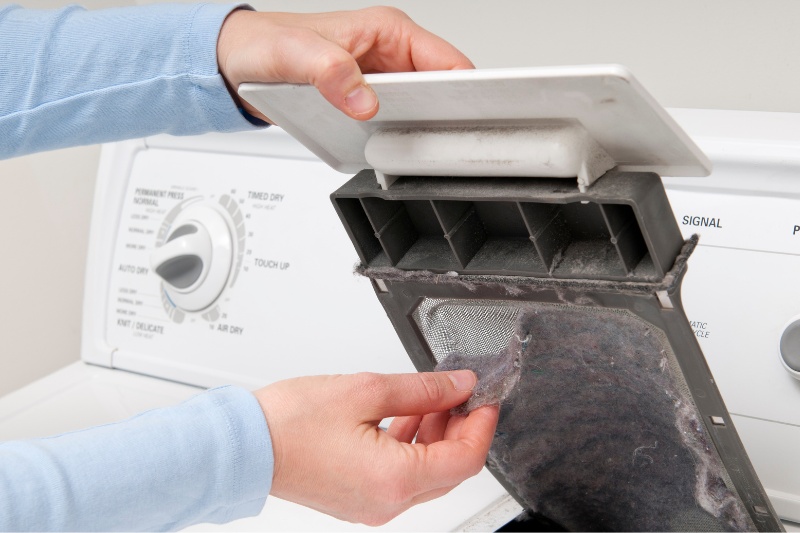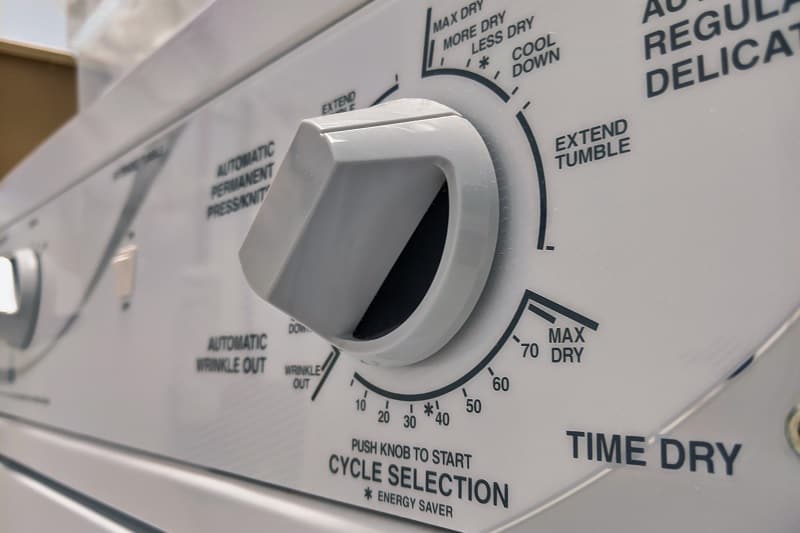Tumble dryers are a saviour for many. Some of us don’t have time to leave things to air dry or just don’t have space for drying! But how long does a tumble dryer take to dry clothes? And how long should it take?
Average Drying Times
Here’s a rough guide to how long different drying cycles will take:
- Cotton and linen (large load, cupboard dry): 150 minutes
- Cotton and linen (medium load, cupboard dry): 82 minutes
- Cotton and linen (large load, iron dry): 113 minutes
- Cotton and linen (medium load, iron dry): 55 minutes
- Synthetics (medium load, cupboard dry): 65 minutes
- Synthetics (small load, cupboard dry): 35 minutes
- Synthetics (medium load, iron dry): 54 minutes
- Synthetics (small load, iron dry): 30 minutes
- Delicates (medium load, cupboard dry): 135 minutes
- Delicates (small load, cupboard dry): 60 minutes
- Synthetics (medium load, iron dry): 105 minutes
- Delicates (small load, iron dry): 45 minutes
These are just rough averages. The exact time will vary depending on the factors below.
Things That Affect Drying Time
1. Type of tumble dryer

There are four types of tumble dryer available in the UK:
Each of these dryer types has a different way of dealing with the water that comes from the wash load and they all come with their own list of pros and cons.
With regards to the length of drying time, some dryers have a timer and run until this time is up, while others have inbuilt sensors and can stop as soon as the load is dry.
These different types of tumble dryers can range quite drastically in drying time.
Vented tumble dryers, although less energy-efficient than condenser dryers are more likely to dry your laundry quicker.
Heat pump tumble dryers are actually slower again, as they use cooler temperatures to dry clothes (which can be better for your clothing’s lifespan).
Washer dryer combos are probably the least efficient of the four, as they often have limited drum space, meaning your laundry doesn’t get the same room to move and air out.
2. Dryness level on tumble dryer
Tumble dryers with sensors can be set with a specific dryness level – these are usually labelled as:
- Iron Dry – Leaves clothing slightly damp so that ironing is easier – ironing should be done immediately after the load comes out of the dryer.
- Hanger Dry – For items which don’t need to be ironed as once hung up, light creases will fall out.
- Cupboard Dry – To ensure the wash load is completely dry and ready to be put away as soon as it comes out of the dryer.
- Extra Dry – Ideal for jeans, bedding and towels as this is a longer drying time setting.
Using these specific settings means that your tumble dryer won’t waste time and energy by running for longer than it needs to.
3. Wetness of laundry
Obviously, the more saturated your laundry is with water, the longer it will take to dry. Selecting a higher spin speed on your washing machine can help remove excess water, helping your clothes dry more quickly.
4. Load size
The more clothes you add to the dryer, the longer they will take to dry.
5. Capacity
A larger capacity tumble dryer can prove to be more effective at drying clothes due to the room inside the drum allowing for the hot air to really circle around the laundry and get every last item dry. When it comes to dryers, the bigger the drum, the better.
6. Energy efficiency
If your dryer has a better energy efficiency or eco-rating it is not just better for the environment but it can also give you faster drying times, therefore saving you money on your bills!
The cost of running a tumble dryer will depend on the energy-efficiency of your dryer. However, you do generally pay more for a better energy efficiency rating and a higher quality tumble dryer.
Many modern tumble dryers have a reverse tumble capability which means your wash load gets tumbled in both directions, allowing clothes to dry quicker and reduce their creasing.
How Long Should a Good Tumble Dryer Take?
As we’ve mentioned, a tumble dryer, much like a washing machine, has multiple settings for drying different laundry loads.
An average wash load should take between 30-45 minutes to dry in a good tumble dryer, with an average time of about 40 minutes for most clothing items. However, items like jeans and towels will take longer to dry than other items, so may need to be kept in longer.

Tips to Shorten Drying Times
Your dryer could be used more efficiently if you take extra steps to follow these tips below:
- Wash at a high spin rate – Spin clothes at the highest suitable speed in the washing machine so they come out dryer in the first place.
- Group together similar items – If you dry items with similar fabrics and weights together, they will likely be dry all at the same time. Popping a big heavy towel in with your regular cotton t-shirts will just lead to your tops getting overly dried while your towel needs a fair amount longer.
- Don’t overfill the drum – Not only will this severely reduce the efficiency of your tumble dryer but it could also lead to breaking it. A simple rule of thumb is that your hand should fit in lengthways easily above the wash load line inside the drum.
- Pop in a dry towel – This will absorb moisture from your clothes readily, meaning less drying time.
- Use dryer balls – These help increase the hot airflow around the drum and amongst your clothes. They can help to cut drying time by around 20-30% and help to soften laundry too. Dryer balls like these are a great investment as they can last for absolute ages!
- Use the right settings – E.g. if you’re drying delicates such as lingerie, then use the delicates setting. This ensures that your tumble dryer knows what it’s drying and for how long.
- Tumble dryer maintenance – Read on to discover what could be slowing down your dryer.
Is Your Dryer Taking Too Long?

If you’re already following the tips above to reduce drying time, then you might have a little problem in your tumble dryer which is causing this. This can be something quite small and very easy to fix, so don’t worry.
Basic things to look for in any type of dryer are:
- A blocked lint filter – These are located in the door frame and should pop out and clip back in easily. Remove this filter and open it up to remove lint which has built up during a wash. Rinse the empty filter with warm water to ensure it is clean before putting it back in its place.
- A dirty sensor – The little sensor which tells your tumble dryer when the clothes are at the required dryness could be hindered by a build-up of dust or dirt. This is located inside the drum, just under the door frame so is super easy to wipe clean with a damp soft cloth. Give the sensor a wipe once a month to ensure it stays clean.
Slow drying vented dryer?
As well as checking the two things above, check the vent hose at the back of the machine. Make sure there are no tears or damaged areas along the hose and remove any blockages – a quick vacuum inside the tube will get rid of dust and fluff that could be blocking the heat from effectively leaving the tumble dryer.
Slow drying condenser dryer?
As with the lint filter, the heat exchanger/condenser unit vents could be blocked with fuzz and dust. Remove the large pieces you can easily get to and then rinse the unit under a warm tap lengthways.
Another reason for your condenser dryer taking ages to dry laundry could be down to a full reservoir. This is a super easy fix! Just remove the reservoir from your tumble dryer and empty it – this should be done regularly to keep your machine in working order.
How Long to Leave Clothes in a Dryer
It is best to remove clothes from a dryer as quickly as possible to reduce the chances of them creasing. Some machines are equipped with a ‘Crease Care’ function which will move the drum intermittently even after the drying cycle has finished, just to ensure deep creases do not form in your clothes.

In The Wash is your guide to the best laundry and cleaning products, tips and tricks. Our mission is to solve the UK’s cleaning and laundry dilemmas!






